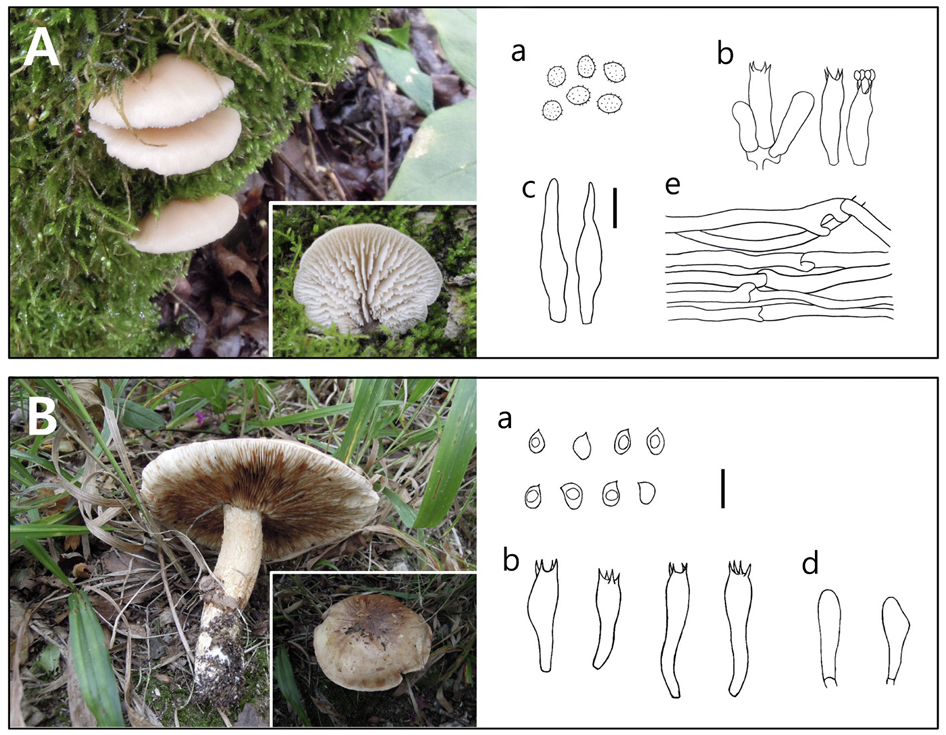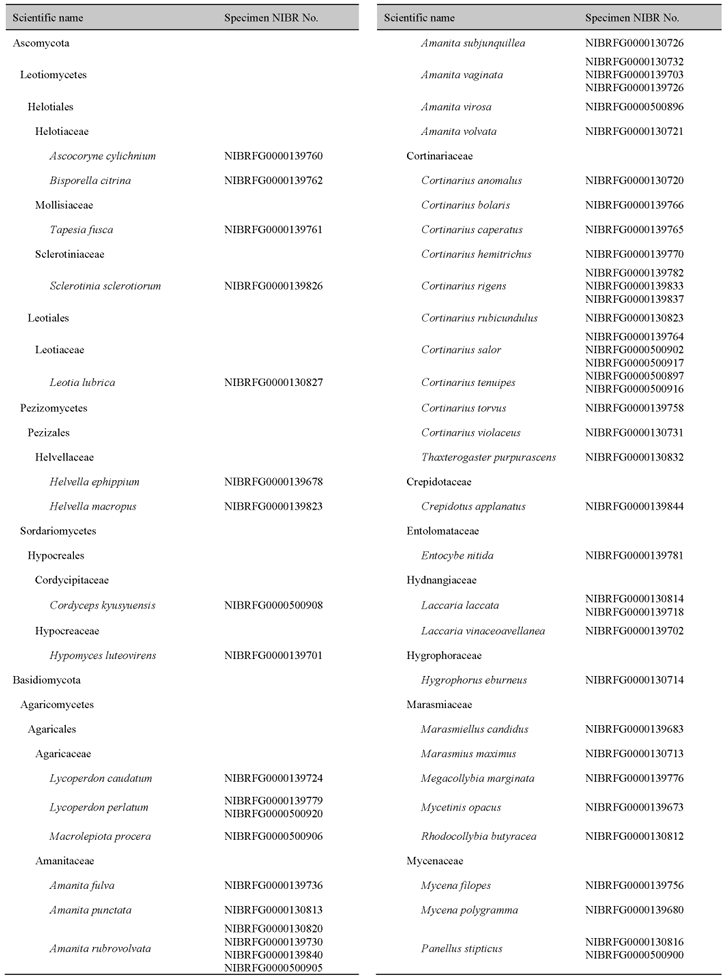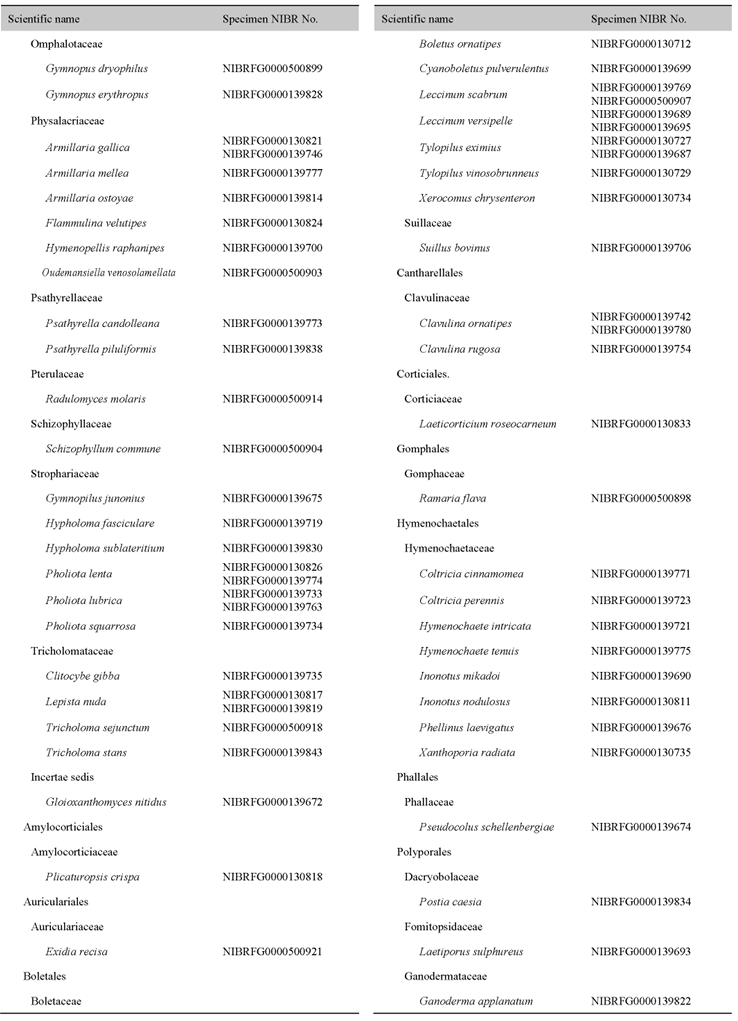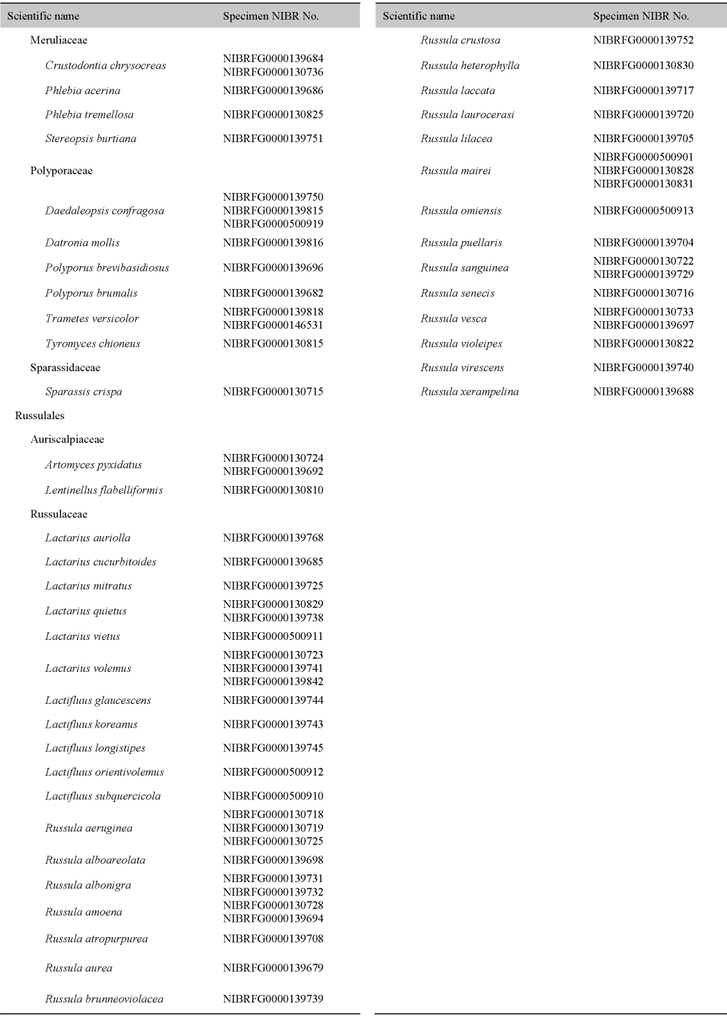Mount Sohwangbyeongsan, situated within the boundaries of Odaesan National Park in Pyeongchanggun, Gangwon-do, was designated as an intensive investigation area from 2013 to 2016. This mountainous terrain includes both a military zone and an alpine meadow region. Portions of this area were designated as military protection zones, accessible exclusively with military authorization, resulting in reduced human interference and nature preservation. The higher altitudes of the mountain reveal vast grassy pastures with minimal forestation. Additionally, these high-altitude areas are frequently enveloped in fog, creating a consistently humid and distinctive environment conducive to mushroom growth. The military-restricted zones, with their limited public access and well-preserved natural conditions, presented an ideal opportunity for the discovery of new mushroom species. This research aimed to comprehensively assess the fungal diversity on Mt. Sohwangbyeongsan through a collection survey of native macrofungi. Through detailed taxonomic investigations of the specimens collected from the mountain, we sought to identify previously undocumented species. These newly recognized species have been included in the Korean National Species List [1], contributing to biodiversity research.
The Korean National Institute of Biological Resources conducted seven fungal collection surveys on Mt. Sohwangbyeongsan within Odaesan National Park between 2013 and 2016. During these surveys, a total of 214 mushroom specimens were obtained. Each specimen underwent preliminary identification based on its macroscopic morphology. When necessary, further identification was pursued through a detailed microstructure examination using a microscope. Measurements and drawings were conducted employing a Nikon Eclipse 80i microscope (Nikon, Tokyo, Japan). In the process of identifying and describing two previously unrecorded species, twenty randomly selected mature basidiospores and basidia from each specimen were assessed and cross-referenced with published descriptions [2-7]. To facilitate genetic identification, total DNA was extracted from dried specimens using the AccuPrep Genomic DNA Extraction Kit (Bioneer, Daejeon, Korea). The internal transcribed spacer (ITS) region was then amplified using primers specifically designed for ITS1F and ITS4B [8]. DNA sequencing was performed at the DNA Synthesis and Sequencing Facility, Macrogen (Seoul, Korea) utilizing the primers mentioned above. The nucleotide sequences acquired were edited using MEGA 5 software [9] and subsequently deposited in GenBank. Species identities were verified by comparing the obtained nucleotide sequences with reference sequences from GenBank through BLASTn. A neighbor-joining phylogenetic analysis was executed within MEGA 5 software, incorporating Jukes–Cantor correction. The reliability of the inferred neighbor-joining topologies was assessed via 500 bootstrap replicates. Combining both morphological and phylogenetic analyses, all fungal taxa were enumerated and classified according to contemporary taxonomies. Taxonomic classification and nomenclature were assigned based on the Index Fungorum database (http://www.indexfungorum.org/).
The survey successfully identified a total of 137 macrofungi species in Mt. Sohwangbyeongsan within Odaesan National Park. These species were systematically categorized into 2 phyla, 4 classes, 15 orders, 41 families, and 73 genera (Appendix 1). Notably, this survey led to the discovery of two species�Lentinellus f labelliformis (Bolton) S. Ito 1959 and Tricholoma stans (Fr.) Sacc. 1887�marking their first recorded appearances in Korea. In this report, we provided photographic documentation of the fruiting bodies, detailed drawings of microscopic features (Fig. 1), comprehensive species descriptions, and insightful discussions. For scientific reference, the nucleotide sequences of these two species have been deposited in GenBank (accession numbers: OR701405 and OR976507). These sequences were compared to GenBank reference sequences and subsequently identified using ITS regions sequence analysis (Fig. 2). In particular, one specimen (NIBRFG0000130810) formed a distinct monophyletic clade with the reference sequence of L. flabelliformis, exhibiting a substantial bootstrap support of 90% and a sequence similarity of 99.7%. Likewise, another specimen (NIBRFG0000139843) established a monophyletic clade with the reference sequences of T. stans, marked by a robust bootstrap support of 100% and a sequence similarity of 100% (Fig. 2).
Fig. 1
Fruiting bodies and microscopic features of Lentinellus flabelliformis (A) and Tricholoma stans (B). a, basidiospores; b, basidia; c, pleurocystidia; d, basidioles; e, generative hyphae. Scale bar=10 μm.

Fig. 2
Neighbor-joining tree of two unrecorded species constructed using internal transcribed spacer sequences. Bootstrap scores of >50 are presented at the nodes. The scale bar indicates the number of nucleotide substitutions per site. A, Lentinellus flabelliformis; B, Tricholoma stans.

A thorough examination of macrofungi species within Mt. Sohwangbyeongsan was conducted. A total of 214 collections were identified and classified down to the species level following contemporary classification systems, ultimately resulting in a comprehensive checklist comprising 137 species. These species, span across 7 families within the Ascomycota, including Helotiaceae, Sclerotiniaceae, Mollisiaceae, Leotiaceae, Helvellaceae, Pezizaceae, Cordycipitaceae, and Hypocreaceae. Additionally, we identified 128 species distributed among 34 families within the Basidiomycota, such as Agaricaceae, Amanitaceae, Amylocorticiaceae, Auriculariaceae, Auriscalpiaceae, Boletaceae, Clavulinaceae, Corticiaceae, Cortinariaceae, Crepidotaceae, Dacryobolaceae, Entolomataceae, Fomitopsidaceae, Ganodermataceae, Gomphaceae, Hydnangiaceae, Hygrophoraceae, Hymenochaetaceae, Marasmiaceae, Meruliaceae, Mycenaceae, Omphalotaceae, Phallaceae, Physalacriaceae, Polyporaceae, Psathyrellaceae, Pterulaceae, Russulaceae, Schizophyllaceae, Sparassidaceae, Strophariaceae, Suillaceae, Tricholomataceae, and Incertae sedis. Among these, the families Amanitaceae, Boletaceae, Cortinariaceae, and Russulaceae emerge as dominant flora throughout the mountain (Appendix 1). Of notable interest, we confirmed the presence of two species, L. flabelliformis and T. stans, as new additions to the Korean fungal diversity. Although the number of fungal species may not be as extensive as those found in inland national parks, we uncovered a diverse spectrum of macrofungi within this area, highlighting the unique macrofungal flora of Mt. Sohwangbyeongsan. Given its location in the alpine region of the eastern Korean Peninsula and its remarkable array of previously undocumented fungal taxa, this mountain holds significant potential for phylogeographical research.
Taxonomy
Basidiomycota R.T. Moore
Agaricomycetes Doweld
Agaricales Underw
Tricholomataceae R. Heim ex Pouzar
Tricholoma stans (Fr.) Sacc., Sylloge Fungorum 5: 94 (1887)
Korean name. Gi-Dung-Song-I, nom. nov. (기둥송이),
Pileus 8 cm across, convex becoming almost planar, smooth, viscid, reddish brown to grey brown with a pale margin, very weakly striate. Gills white or cream to reddish brown, moderately crowded, emarginate. Stem initially white, becoming pale brown, cylindrical, smooth or finely longitudinally fibrillose, 7.5 cm long, 1.8 cm diameter, no stem ring. Flesh White, turning brownish when handled. Basidia clavate 20.437.7×5.2-7.5 µm with 4 sterigmata 2.8-3.7 µm long. Basidospores ellipsoidal, smooth, 4.1-6.7×3.1-5.0 µm. Spore print white. Odour/taste indistinct, farinaceous taste.
Specimen examined: NIBRFG0000139843 (37.76641N, 128.66808E; GenBank accession No. OR976507): habitat, soil, and solitary
Note: Tricholoma stans is so rare that careful microscopic studies are required. T. pesundatum is a similar species; however, it differs in exhibiting a stronger farinaceous odor and taste, and its spores are significantly narrower.
Russulales Kreisel ex P.M. Kirk, P.F. Cannon & J.C. David
Auriscalpiaceae Maas Geest.
Lentinellus flabelliformis (Bolton) S. Ito 1959
Korean name. Pyeon-Sim-Teol-Neu-Ta-Ri, nom . nov. (편심털느타리),
Pileus 2.7 cm across, a thin, compact, hairy upper layer, and a thick, soft, white to light brown lower layer that is made of thin, thread-like filaments arranged, laterally stipitate. Stipe is similarly divided, with a thin, dark and hairy cortical layer covered by hairs, which encircles inner ochre-colored flesh.; Blades subdecurrent to decurrent, close to subspaced, with lamellae, whitish to pale brownish, with deeply toothed edges; Pleurocystidia fusiod to subclavate, 27-48×7.3-9.4 µm, hyaline with clamp connections; Basidia clavate 27.7-30.5×6.5-7.7 µm with 4 sterigmata 2.1-3.3 µm long; Basidiospores subglobose to broadly ellipsoid, thin-walled, spinose with fine apicle, without germ pore, hyaline, 5.6-7.0×4.3-5.1 µm.
Specimen examined: NIBRFG0000130810 (37.76528N, 128.67183E; GenBank accession no. OR701405); habitat: dead hardwoods and conifers, solitary or gregarious.
Note: The species of Lentinellus is easy to identify because of their spinose and amyloid basidiospores. In particular, L. flavelliformis cannot be confused with any other taxon because it has laterally stipitated basidiomata and clamp connections.





